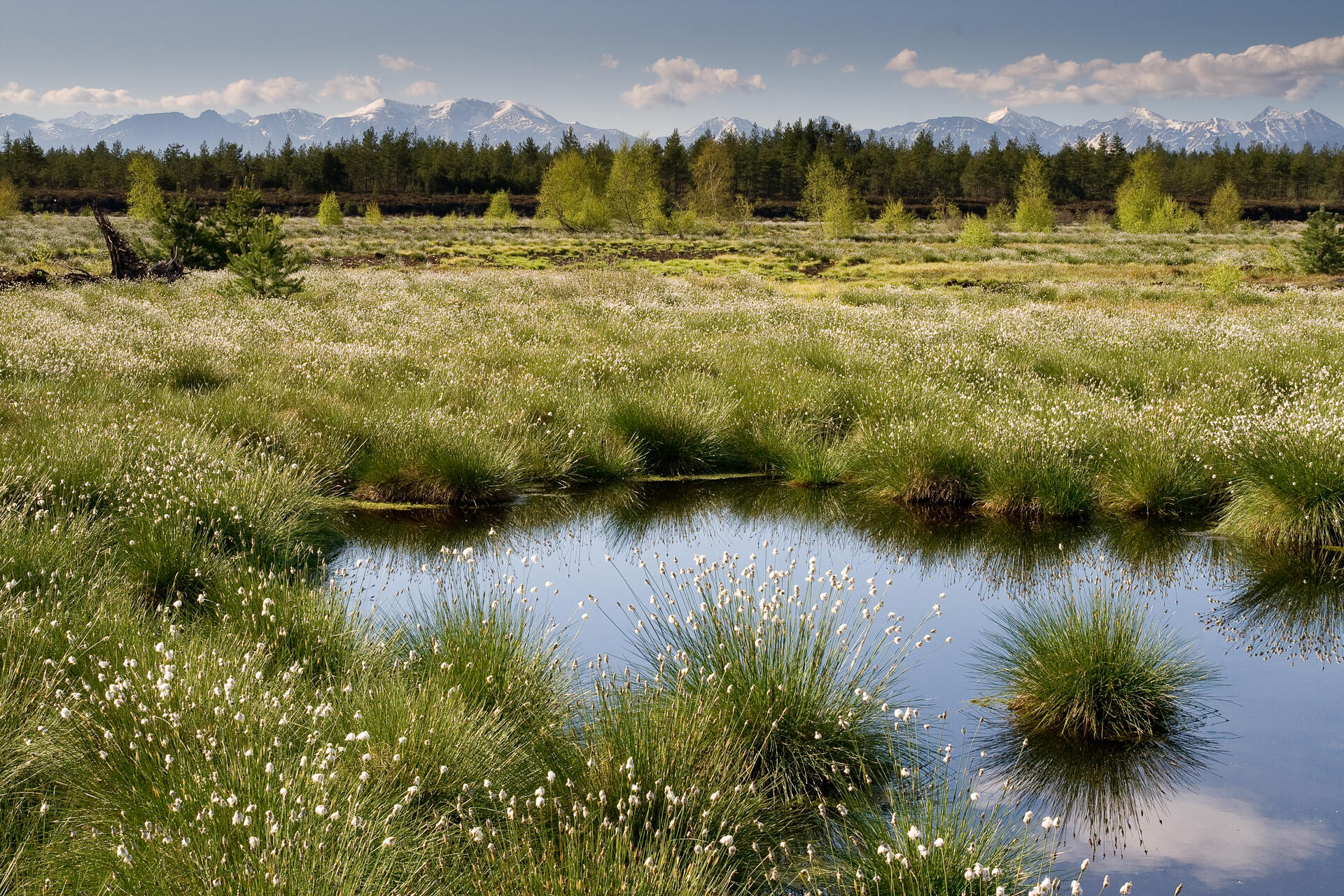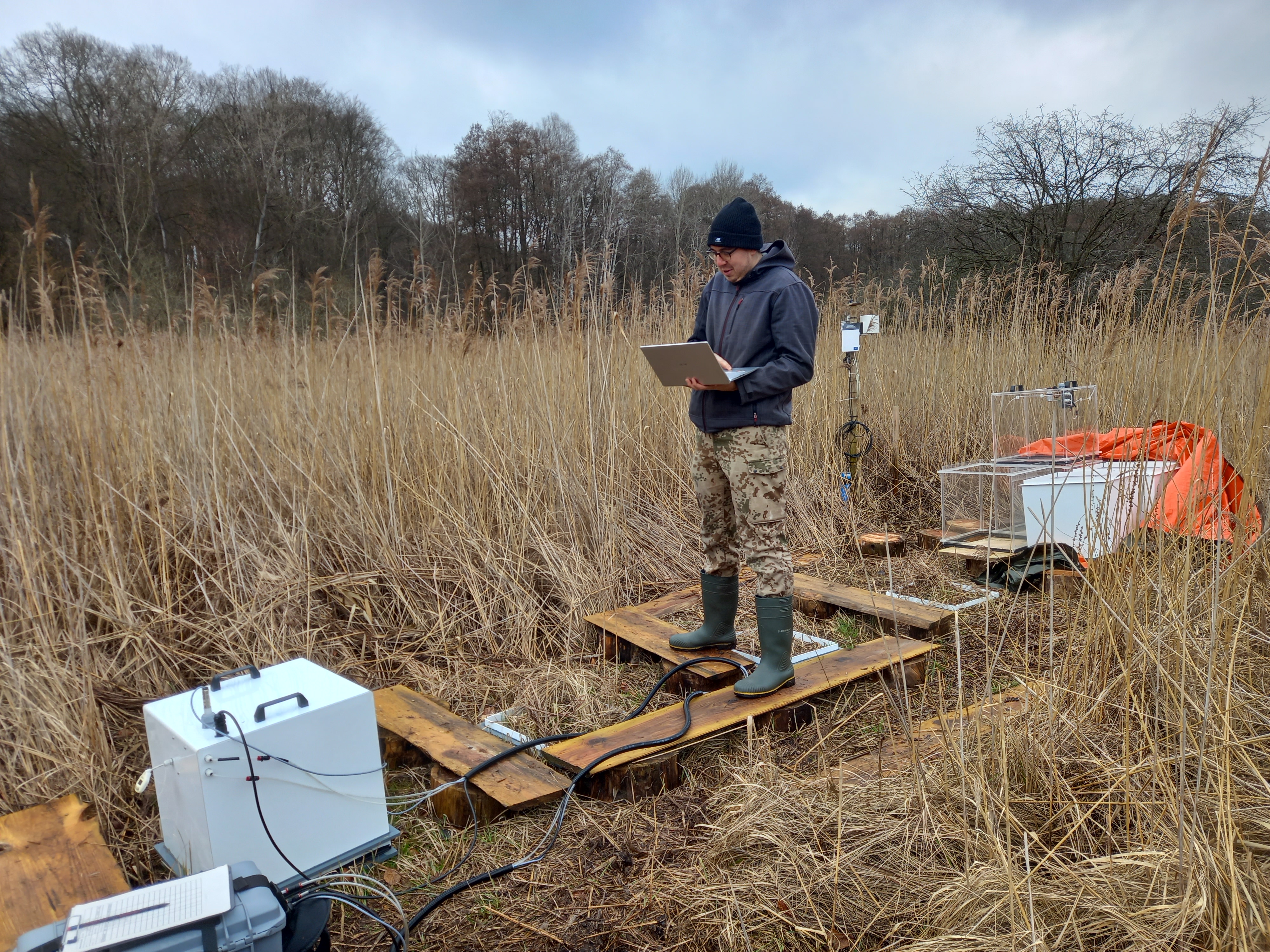
Raised bog in the Polish Carpathian with flowering cotton gras (Eriophorum vaginatum). Photo: Tomasz Wilk.
Humboldt University and Humboldt Innovation are participating in the monitoring of the LIFE Multi Peat project, promoting its accelerated implementation, and providing necessary equipment. The aim of the project is the restoration and, in parts, the transition to wet peatland management of project fields in Poland, Germany, Belgium, the Netherlands, and Ireland. Functional peatlands significantly contribute to climate and species protection. From 2021 to 2026, with the support of the LIFE Climate Change Mitigation Programme, researchers will work to restore the natural functioning of peatlands. The project area in Germany is the "Häsener Luch" in Löwenbergerland, Brandenburg.

Greenhousegas measurements with chamber method in a reed stand (Phragmitis australis) in Häsener Luch. Photo: Marvin Gabriel.
Peatlands as vast CO2 stores
The restoration of peatlands is of enormous importance for climate protection because healthy peat landscapes store greenhouse gases, thus contributing to climate regulation, fulfilling important ecosystem functions, providing flood protection, filtering groundwater, and providing a habitat for threatened animal and plant species. It has catastrophic consequences when peatlands lose their function, mainly due to drainage for agricultural and forestry purposes, leading to microbial degradation of peat. In Germany, about 95% of peatlands are drained. As a consequence, peat areas can no longer store organic carbon and release it in massive amounts. For instance, the drained mainly agricultural peatland "Häsener Luch" emits an estimated 1290 tons of CO2 equivalent per year on an area of about 50 hectares.
For Europe, the figures indicate that the EU, globally, is the second-largest emitter of greenhouse gases from peatlands. In Germany, seven percent of greenhouse gases are attributable to drained peatlands.

Successfully rewetted Alder carr (Alnus glutinosa) at the end of the winter in Germany. Photo: Marvin Gabriel.
Peatland rewetting and restoration with LIFE Multi Peat
The reduction of greenhouse gases is intended to be achieved within the framework of LIFE Multi Peat through peatland rewetting and consequent raising of the water table. Specifically, this means restoring 689 hectares of peatland, reducing the global warming potential of the affected peat landscapes by up to 50%, developing strategies for paludiculture (wet peatland management) in Germany and Belgium, enabling improved communication and coordinated cooperation among EU peatland projects, and developing recommendations for expanding peatland restoration and an EU-wide decision support system for authorities and the private sector.

Raised bog with Sphagnum cushions in the Polish Carpathian. Photo: Tomasz Wilk.
HU and HI support LIFE project in monitoring
Humboldt University and Humboldt Innovation support the project in monitoring, playing an important role in the implementation of LIFE Multi Peat. Through HI, accelerated processing and procurement of necessary equipment, such as specialized measuring devices or gas analyzers, are possible. The research team can also utilize university laboratories through them to conduct specific measurements. As part of the project, the progress and success of the targeted reduction of greenhouse gas emissions are documented through monitoring. Under the leadership of HU Acting Professor Dr. Kathlin Schweitzer from the Department of Soil Science and Site Science, students and graduates of the department are involved in the NABU team. The faculty has a long tradition in peat soil research and is where a significant number of researchers currently working in the peat sector were trained.
Watertable sensor in flooded hand cut peat bank in Häsener Luch (Germany). Photo: Andreas Herrmann.